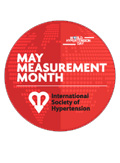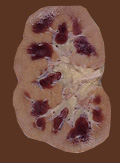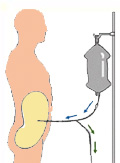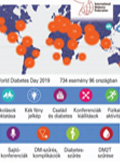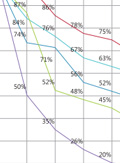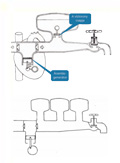The eLitMed.hu medical portal uses computer cookies for convenient operation. Detailed information can be found in the Cookie-policy.
Hypertension and nephrology - 2019;23(02)
Content
[Hungarian dialysis statistics: changing trends in the renal epidemiology]
[In the last 30-35 years, dialysis care in Hungary has been a major development: both the incidence and prevalence of patients have increased year by year. Over the last decade, growth has slowed and is becoming more and more stabilized (similar trends can be seen in dialysis statistics in developed countries). Behind the dialysis indication the acute kidney injury (AKI) is more common than the end-stage renal disease (ESRD). The latter incidence has been stable for last 6 years (200-230 patient/million population). The annual average growth rate of prevalent dialysis patients was only 0.9%/year in the last 6 years. Among prevalent dialysis patients, the proportion of diabetic patients has remained unchanged for 10 years (26-27%), but those have increased who had hypertension nephropahty. The average age of incident and prevalent dialyzed patients has decreased gradually over the past 8 years (between 2009 and 2017 incident rate was from 67.1 to 63.0 years, prevalent rate was from 65.6 to 61.8 years). Unfortunately, just over half of the patients who dialyzed due to chronic kidney disease (CKD) have reached dialysis day 91. This is due to the high proportion of patient who was in urgent need of dialysis. In chronic hemodialysis (HD) program, the proportion of patients treated with arterovenous fistulas (AVF) decreases, while the rate of central venous catheter (CVC) users increases. The Hungarian peritoneal dialysis program in Europe is very good. The number of prevalent patients receiving renal replaement therapy (RRT) in Hungary in 2017 was 1005 for 1 million inhabitants.]
[Diabetology in dialysis]
[According to epidemiological data, the number of diabetic patients requiring dialysis is increasing. Burnt-out diabetes, new onset diabetes during chronic dialysis treatment and new onset diabetes after transplantation diabetes are new types of diabetes compared to the traditional division forms. It is utmost important to evaluate education ability and acceptance the core values of lifestyle changes. Clear guidelines for oral anti-diabetic and insulin therapy have not yet been developed since this group of patients did not participate in previous major surveys. In order to formulate individualized therapeutic recommendations, it is imperative to perform regular glucose self-monitoring, which is also the cornerstone of solving unexpected situations. Both in hemodialysis and peritoneal dialysis, special considerations should be applied to the diabetic patient group, this review focuses on the current understanding of available relevant knowledge and summarizes presumably extrarenal diabetic complications as well.]
[Serum uric acid level in hypertension. Domestic experience based on the data of the Hungarian Hypertonia Register 2011., 2013., 2015. Part I. Introduction. Patients and methods. Basic data]
[Worldwide, screening in the general population detects an increase in serum uric acid levels in both sexes. This growth trend is also valid for hypertension. Authors studied the incidence of serum uric acid levels and its correlation with age, risk factors, anthropological, metabolic characteristics, blood pressure, blood pressure target, organ damage, age-related co-morbidity and drug therapy in 47,372 hypertensive patients (22,688 males, 24,684 women). In the first part of their analysis they present the method of analysis and the basic correlations. The uric acid level is higher in men than in women, with the advancement of age increasing. Increases in systolic and diastolic blood pressure are associated with increases in serum uric acid levels, with a tendency for systolic pressure to be significantly higher. For ladies, the rising trend is smaller and always lower in uric acid values. The uric acid value is higher in patients with the non-target blood pressure. The presence of co-morbidity significantly increases serum uric acid levels.]
[One-year persistence of fixed-dose combinations of angiotensin-converting enzyme inhibitor and calcium channel blocker in hypertensive patients]
[Introduction: The most recent European guidelines for the treatment of hypertension suggest the use of renin-angiotensin-aldosterone system antagonists (RAAS inhibitors) and calcium channel blockers (CCBs) or diuretics fixed-dose combinations (FDCs) as the first therapeutic option. In antihypertensive therapy, the patient’s adherence is one of the most important factors in reducing unwanted cardiovascular events. Aim: Our aim was to assess the one-year persistence of angiotensin-converting enzyme inhibitor (ACEI) and CCB FDCs in hypertensive patients. Method: Authors have analysed the prescription database of the National Health Insurance Fund in Hungary on pharmacy claims between October 1, 2012 and September 30, 2013. Those patients were identified who filled prescriptions for FDCs of ACEI and CCBs prescribed for the first time for hypertensive patients and who had not re ceived similar drugs during the year before. Apparatus of survival analysis was used, where ‘survival’ was the time to abandon the medication. Results: 124,388 patients met the inclusion criteria. One-year persistence rate and hazard ratio (HR) of discontinua tion in patients with ramipril/amlodipine FDC was 54% (HR = 1.00, reference), perindopril/amlodipine 47% (HR = 1.30, p<0.0001), lisinopril/amlodipine 36% (HR = 1.79, p<0.0001), ramipril/felodipine 26% (HR = 2.28, p<0.0001) and trandolapril/verapamil 12% (HR = 4.13, p<0.0001). The average survival time of drug limited to 360 days was 270.2 days for ramipril/amlodipine FDC, 242.7 days for perindopril/amlodipine FDC, 211.2 days for lisinopril/amlodipine FDC, 186.3 days for ramipril/felodipine FDC and 125.7 days for trandolapril/verapamil FDC. Conclusions: The authors demonstrated that the one-year persistence of ACEI/CCB FDCs was significantly different in hypertensive patients. Ramipril/amlodipine FDC was more advantageous for patient adherence.]
[Circulatory dinamics assay about lercanidipine treatment]
[Lercanidipine is of unique importance amongst calcium channel blockers. In the first section, the author creates two visual analogies to demonstrate the effect of calcium channel blockers. The control of the parallelism of the particular elements of the model of circulatory dynamics, and the biostructure was supported by an engineer of flud dynamics. In the second part, he deals with the effect of these drugs exerted on the pulmonary circulation and renal function, primarily for mind-raising purposes. He focuses on the edema induced by dihydropyridines, pays attention to its patomechanism, prevention and therapy, highlighting the distinctive benefits of lercanidipine. The presence or disappearance of this adverse effect may arbitrate whether this effective and valuable pharmacological intervention should stand the test of clinical practice.]
1.
Clinical Neuroscience
Is there any difference in mortality rates of atrial fibrillation detected before or after ischemic stroke?2.
Clinical Neuroscience
Factors influencing the level of stigma in Parkinson’s disease in western Turkey3.
Clinical Neuroscience
Neuropathic pain and mood disorders in earthquake survivors with peripheral nerve injuries4.
Journal of Nursing Theory and Practice
[Correlations of Sarcopenia, Frailty, Falls and Social Isolation – A Literature Review in the Light of Swedish Statistics]5.
Clinical Neuroscience
[Comparison of pain intensity measurements among patients with low-back pain]1.
Clinical Neuroscience Proceedings
[A Magyar Stroke Társaság XVIII. Kongresszusa és a Magyar Neuroszonológiai Társaság XV. Konferenciája. Absztraktfüzet]2.
3.
Journal of Nursing Theory and Practice
[A selection of the entries submitted to the literary contest "Honorable mission: the joys and challenges of our profession" ]4.
Journal of Nursing Theory and Practice
[End of Life and Palliative Care of Newborns in the Nursing Context]5.
Journal of Nursing Theory and Practice
[Aspects of Occupational Health Nursing for Incurable Patients ]



